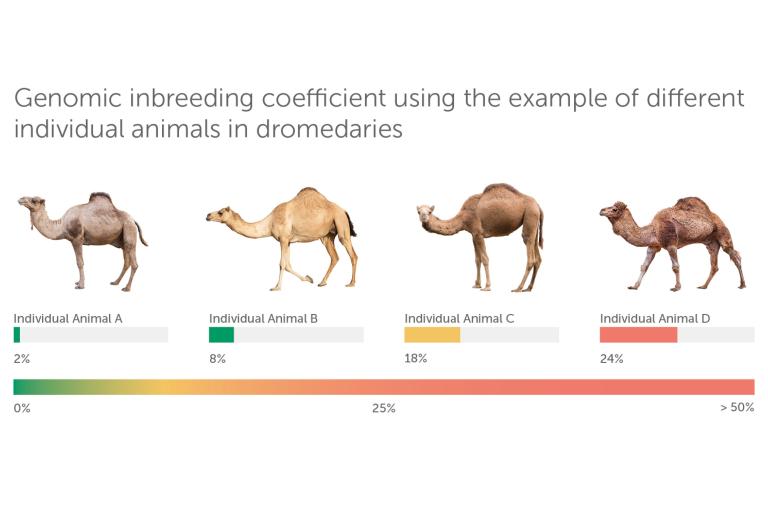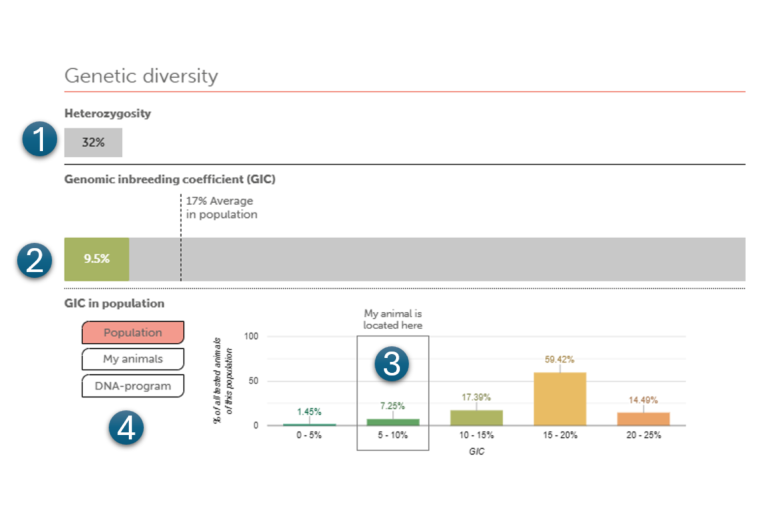Heterozygosity and Genomic inbreeding coefficient
Heterozygosity
Heterozygosity serves as a valuable metric for quantifying genetic diversity. It measures the proportion of gene loci in an animal's genome where two different alleles are present. In contrast, homozygosity refers to gene loci where the alleles are identical. While heterozygosity alone may not provide a comprehensive assessment of an animal's inbreeding status, it can indicate a substantial loss of genetic diversity. This underscores the importance of considering heterozygosity when evaluating an animal's genetic makeup.
Genomic inbreeding coefficient
Genomic inbreeding coefficient (GIC) measures the proportion of the individual's DNA that has been inherited from recent common ancestors, and thus gives a measure of the percent of the individual's genome that is inbred.
Traditionally, the inbreeding coefficient was estimated using pedigree records. This method had significant limitations, primarily neglecting inbreeding events that occurred before the evaluated generations.
At Generatio, we determine the actual inbreeding status of an animal using genomic information obtained from SNP-array analysis. This advanced approach assesses the variability of an animal's genome across its species, indicating the level of inbreeding, including background inbreeding from domestication and breed development. This measure is known as the genomic inbreeding coefficient (GIC).
By using genomic data, it becomes possible to determine the genetic inbreeding status of an animal without precise knowledge of the relatedness of its parents or other ancestors. This method provides a more accurate and comprehensive understanding of an animal's genetic diversity and inbreeding level.
Please note that high individual GIC values do not automatically result in the animals exclusion from future breeding. However, it is crucial to find breeding partners for these animals that possess low GIC values and different ROH profile patterns. This approach would likely increase the genetic variability of the offspring, preventing the long-term loss of heterozygosity in the population and mitigating the effects of inbreeding depression.
Testing and Results
Heterozygosity and GIC are displayed in the animal's record as soon as they are available. You can find them under the "Genetic Diversity" section:
- Heterozygosity and GIC are analysed with our test for inbreeding&fitness for dogs and camels. The heterozygosity level is represented as a percentage value. Normal values fall within a specific range, while high or low values indicate special genetic diversity or inbreeding, respectively.
- The GIC is also displayed as a percentage within a colored bar. The color and length of the bar provide information about the degree of inbreeding. A green bar indicates a low value, while a red bar suggests a higher value. Values range from 0 to 50 or above are not expected. A dashed line represents the current inbreeding value of the entire population.
- The grey frame in this diagram shows the position of my animal compared to other animals in the population. In this example, my animal with a value of 9.5% is located within the secound bar, representing animals with similar values (5-10%). The colored number above the bar indicates that 7,25% of all animals in the population also have values between 5% and 10%. In the adjacent bar, which represents values from 10-20%, 17,39% of all animals in the population are located.
- The options on the left side allow me to compare my animal to other populations. "My animals" shows my animal compared to my other animals of the same breed, and selecting a DNA program shows my animal compared to animals within that group.



